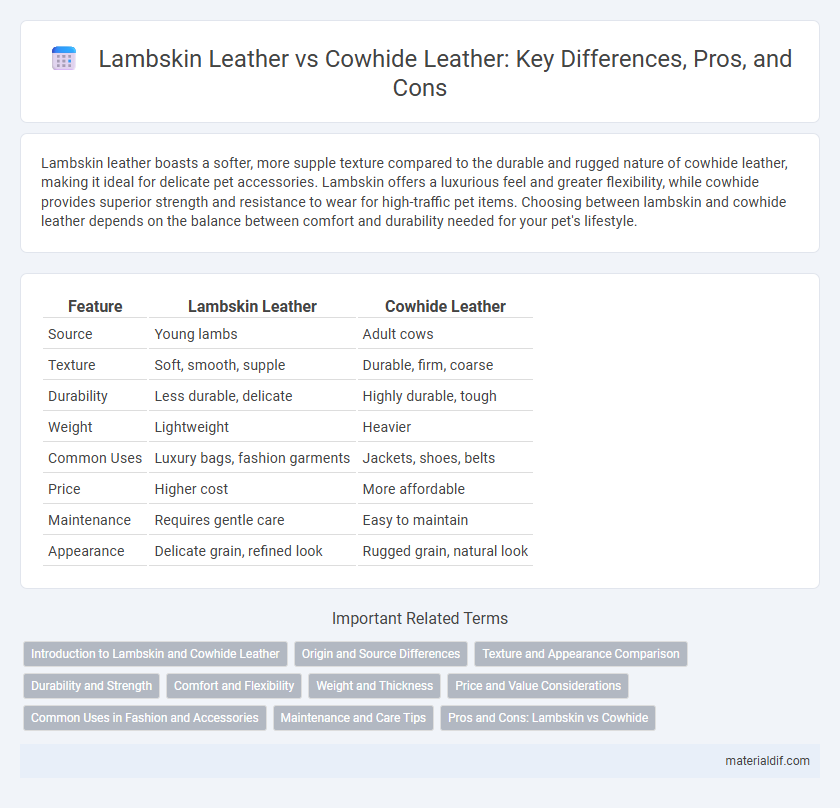Lambskin leather boasts a softer, more supple texture compared to the durable and rugged nature of cowhide leather, making it ideal for delicate pet accessories. Lambskin offers a luxurious feel and greater flexibility, while cowhide provides superior strength and resistance to wear for high-traffic pet items. Choosing between lambskin and cowhide leather depends on the balance between comfort and durability needed for your pet's lifestyle.
Table of Comparison
| Feature | Lambskin Leather | Cowhide Leather |
|---|---|---|
| Source | Young lambs | Adult cows |
| Texture | Soft, smooth, supple | Durable, firm, coarse |
| Durability | Less durable, delicate | Highly durable, tough |
| Weight | Lightweight | Heavier |
| Common Uses | Luxury bags, fashion garments | Jackets, shoes, belts |
| Price | Higher cost | More affordable |
| Maintenance | Requires gentle care | Easy to maintain |
| Appearance | Delicate grain, refined look | Rugged grain, natural look |
Introduction to Lambskin and Cowhide Leather
Lambskin leather is prized for its exceptional softness, fine grain, and lightweight texture, making it a popular choice for luxury garments and accessories that require a delicate touch. Cowhide leather offers superior durability, a thicker texture, and robust grain, ideal for heavy-duty products like boots, belts, and furniture that require long-lasting strength. Both leathers stem from different animal hides, with lambskin derived from younger sheep and cowhide sourced from mature cattle, affecting their texture, strength, and typical use cases.
Origin and Source Differences
Lambskin leather is derived from the hides of young sheep, primarily sourced from regions with established sheep farming such as Australia and New Zealand, offering a softer, more delicate texture ideal for luxury products. Cowhide leather comes from mature cattle, predominantly sourced from the United States, Brazil, and India, known for its durability and thicker grain suited for heavy-duty applications. The fundamental difference in origin influences the texture, strength, and final use of each leather type, with lambskin prized for its suppleness and cowhide for its robustness.
Texture and Appearance Comparison
Lambskin leather features a soft, smooth texture with a delicate, supple feel that offers a luxurious appearance, often used in high-end fashion items. Cowhide leather, in contrast, is thicker and more durable with a coarser texture, displaying a rugged, natural grain that darkens and develops character over time. Lambskin's fine grain and light weight make it ideal for garments requiring flexibility, while cowhide's robustness suits heavy-duty applications like furniture and motorcycle gear.
Durability and Strength
Lambskin leather is prized for its softness and supple texture but has lower durability and strength compared to cowhide leather, making it more prone to scratches and wear over time. Cowhide leather is thicker and tougher, offering superior resilience and long-lasting performance, ideal for heavy-use items like jackets and upholstery. The dense fiber structure in cowhide enhances its resistance to abrasion and tearing, ensuring greater protection and durability in demanding applications.
Comfort and Flexibility
Lambskin leather offers superior comfort and flexibility due to its fine grain and softer texture, making it ideal for garments and accessories that require a supple feel. Cowhide leather is thicker and more durable, providing less flexibility but greater longevity and protection in heavy-use applications. Lambskin's lightweight nature enhances breathability, while cowhide's rigidity suits structured products needing firmness.
Weight and Thickness
Lambskin leather is significantly lighter and thinner than cowhide leather, offering a softer, more supple feel ideal for delicate garments and accessories. Cowhide leather, known for its durability, typically exhibits greater thickness, providing enhanced protection and longevity in heavy-use items like jackets and boots. Weight differences impact comfort and flexibility, making lambskin preferable for lightweight designs while cowhide suits rugged, long-lasting applications.
Price and Value Considerations
Lambskin leather commands a higher price due to its softness, fine grain, and luxurious feel, making it a premium choice for fashion items and accessories. Cowhide leather, more durable and thicker, offers better long-term value for heavy-use products like jackets and furniture because of its strength and resistance to wear. Consumers prioritize lambskin for aesthetics and tactile luxury, while cowhide is favored for cost-effectiveness and lasting durability in practical applications.
Common Uses in Fashion and Accessories
Lambskin leather, renowned for its softness and lightweight texture, is commonly used in high-end fashion items such as luxury jackets, gloves, and handbags that require a supple finish. Cowhide leather, characterized by its durability and thicker grain, is typically chosen for robust accessories like belts, wallets, and heavy-duty boots, offering long-lasting wear and protection. Both leathers cater to distinct fashion demands, with lambskin emphasizing elegance and cowhide focusing on functionality and strength.
Maintenance and Care Tips
Lambskin leather requires delicate maintenance due to its soft, porous texture, necessitating gentle cleaning with mild soap and immediate protection from water to prevent stains and damage. Cowhide leather, being more durable and thicker, tolerates regular conditioning with oils or creams to maintain flexibility and resist cracking, making it easier to handle heavy use. Both types benefit from storing in a cool, dry place away from direct sunlight to preserve their natural quality and prevent fading.
Pros and Cons: Lambskin vs Cowhide
Lambskin leather offers a soft, supple texture and lightweight feel, making it ideal for luxury fashion items, but it tends to be less durable and more prone to scratches compared to cowhide. Cowhide leather is thicker, more durable, and resistant to wear and tear, making it suitable for heavy-use products like jackets and furniture, though it lacks the delicate softness of lambskin. Choosing between lambskin and cowhide depends on the balance between desired softness and long-term durability for specific leather goods.
Lambskin Leather vs Cowhide Leather Infographic

 materialdif.com
materialdif.com